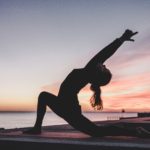Yoga, A Beneficial Practice For Everyone

Yoga has long been known to be beneficial for relieving anxiety, for example, or to loosen your muscles and increase flexibility. However, over time, we discover that yoga also has many benefits for specific people, such as children and pregnant women, as well as for people with Parkinson’s or costochondritis.
Treating costochondritis with yoga
Both athletes and more sedentary people can suffer from costochondritis. It is an intense pain in the chest, sometimes similar to a heart attack, that occurs when the junction of the costal cartilage between the ribs and the sternum temporarily becomes inflamed. The causes of costochondritis are varied, ranging from lack of mobility to a severe cough, poor posture or repetitive physical activity.
In cases of costochondritis, as stated by the American Osteopathic Association, certain yoga postures, if practiced regularly, can improve the strength and flexibility of the surrounding muscles, making the junctions of the rib cage more mobile. These postures are as follows:
Mountain Pose
The Mountain Pose, or Tadasana, is a yoga posture that stretches the upper body. Practiced regularly, it helps to release tension in the chest and shoulder area.
To perform the Mountain Pose, stand with your back straight and your feet hip-width apart. As you breathe in, raise your arms to interlock your fingers above your head. Slowly, hold the position while standing on tiptoes, then hold the position for a moment while working on your balance. Rest your heels on the ground and bring your arms down along your body as you exhale to return to your initial position. Repeat a few times. The Mountain Pose, or Tadasana, is a yoga posture that stretches the upper body. Practiced regularly, it helps to release tension in the chest and shoulder area.
Hero Pose
Also known as Virasana by the more experienced yogis, Hero Pose, through balanced breathing that maintains motion through the thorax, allows your chest to expand. This helps your muscles, joints, and cartilage to keep functioning properly.
The Hero Pose is practiced as follows: kneel down on your mat, glue your thighs, but place your feet on each side of your hips. Take a deep breath to expand your chest and relax your shoulders, always keeping your back straight. If you feel comfortable, you can keep your leg position while lying on the floor. Breathe gently and deeply for a moment, and that’s it! You should practice Hero Pose whenever you get the chance.
Corpse Pose
The Corpse Pose, or Shavasana, is another yoga position recommended for people suffering from costochondritis, as it relaxes the entire body. While the body needs to move and stretch, it also needs to relax! Such a relaxation and deep breathing exercise improves blood circulation, especially in the chest area, while allowing the chest to expand fully.
The Corpse Pose is probably the easiest to do of all. Place your mat on the floor, then lie on it on your back. Separate your legs, and extend your arms at the side of your body with your palms facing up. Breathe slowly and deeply, relaxing all parts of your body, loosening your muscles and removing tension. For best results, hold this position for a few minutes.
Child Pose
Another yoga posture that can relieve costochondritis is the Child Pose or Balasana. This posture allows your blood to circulate in your chest, helping the muscles in that area to function properly. The Child Pose allows the chest to expand but also helps to relax to give a smooth and flexible movement to the thorax.
To place yourself in Child Pose, kneel down on your mat with your knees apart, then bend your body so your glutes move back to level with the top half of your feet. Breathe in, and as you breathe out, extend your arms in front of you and place your forehead on the mat. Breathe gently to relax. Repeat the exercise as often as you like, increasing the duration as you wish!
Yoga can also relieve Parkinson’s disease
Parkinson’s is a neurodegenerative disease that attacks the nervous system, creating movement disorders. Of course, yoga cannot cure such a disease, but it can help a person suffering from it to maintain good flexibility, relax and regain good body awareness. After all, it is essential to stay active to stimulate the nervous system as much as possible, neurologists say so!
Not all positions are achievable with Parkinson’s disease, but some positions that can be practiced on the floor, standing or sitting on a chair are very accessible and beneficial, you just have to find the most suitable ones for the person’s condition.
Standing Forward Bend
The Standing Forward Bend, or Uttanasana, is an energizing yoga posture that elongates the middle and lower back, stretches the hamstrings and calms the body.
To do this, stand with your back straight and your arms relaxed along your body. Breathe for a moment, and as you breathe out, gently bend forward, letting your head hang down. Try as much as possible to keep your knees unfolded, without blocking them, and place your hands or fingertips on the floor to help you keep your balance. Each breath should allow you to release some tension in your lower back and hips. Hold the position for about 10 breaths.
Revolved Abdomen Pose
The Revolved Abdomen Pose, or Jathara Parivartanasana, is a strengthening yoga posture that promotes trunk rotation and induces calm.
To achieve this posture, lie on the floor with your arms extended in a T-shape, palm upwards, bending your knees so that the flat of your feet touch the floor. As you exhale, drop your knees to the floor on one side of your body and turn your head in the opposite direction. Hold the position for 10 breaths, then bring your knees back to their original position before repeating the exercise on the other side.
Reclining Bound Angle Pose
The Reclining Bound Angle Pose, also known as Supta Baddha Konasana for insiders, is a calming posture that helps relieve lower-body stiffness and combat fatigue.
To begin, sit on the end of a surface about 5 inches high and long enough to support your entire back. Make sure you always have excellent support for your body, otherwise the exercise will not be successful. Place the soles of your feet against each other, then lie quietly on your back with your arms on either side of your body, palms up, and eyes closed. Breathe through your ribcage and belly, and direct your breaths to your groins, hips and lower back. Hold the position for about 5 minutes.
Yoga to Soothe Pregnant Women
Practicing yoga is also very beneficial for pregnant women, whether to soothe the mother-to-be and the baby or to prevent certain symptoms such as back pain, nausea, and anxiety. Yoga can also be used in this situation to help prepare the woman for childbirth by improving physical, respiratory and circulatory capacities. Ideally, a short yoga session should be done every morning and evening.
Pigeon Pose
A pregnant woman who suffers from tension in her lower back or stiffness in her hips should definitely practice Pigeon Pose, or Eka Pada Kapotasana, daily.
To do so, get down on all fours. Slide your right leg in front of you so that your right knee is as close as possible to your right wrist and your flex foot is as close as possible to your left wrist. Extend your left leg behind you so that the top of your foot is resting on the ground. If you are able to do so, lower yourself onto your forearms and join your hands together. Hold the pose for a moment and then return to your original position before repeating the exercise on the other side.
Wide-Angle Seated Forward Bend
The Wide-Angle Seated Forward Bend, also known as the Upavistha Konasana, is also an ideal position to relieve back pain, but it also relieves the belly weight by eliminating some pressure on the lower back.
To achieve this posture, nothing could be simpler! Sit on the floor with your legs straight in front of you and spread them as far apart as you can without too much force. With your back always straight, lean your upper body forward and press your forearms to the floor. You should feel a stretch in your hips. Hold the pose for a moment before you relax.
Runner’s Lunge Twist Pose
The Low Lunge Twist Pose, or Parivrtta Sanchalasana, is also ideal for relieving back pain and tightness in the hips.
Get down on all fours. Put your left foot flat on the floor, making sure your knee is directly above your ankle at a 90-degree angle. Then extend your right leg behind you. Shift your weight onto your right hand and extend your left arm up to the ceiling, following your hand with your eyes. Hold the pose for a few seconds and then recreate it on the other side.
Legs-up-the-Wall Pose
For complete relief of the body practice the simplest yoga position of all: the Legs-up-the-Wall Pose, also known as the Viparita Karani.
For a moment of complete relaxation, sit on the floor next to a wall. Lie on your back, then raise your legs so that they rest gently against the wall, keeping the soles of your feet up. Slowly slide your hips forward to touch the wall with the back of your thighs. Then place your hands on your stomach, take a deep breath and enjoy the moment!
Yoga is good for children too!
While the practice of yoga is undeniably beneficial for adults, it is also beneficial for children. Not only can yoga do them a great deal of good physically, but it can also improve their psychological and psychic health.
Among other things, the practice of yoga allows us to develop an awareness of our emotions and feelings, to practice our breathing, and to learn how to calm down and concentrate. It is therefore obvious that children can also benefit from this slowing down in their stimulating days where everything moves quickly and is very performance-oriented.
The ideal would obviously be to allow a child a short yoga session every day, which may seem arduous, but is certainly not impossible. It is not a question of doing a very long and complex session each time, but only of targeting the best postures and linking them together in a short period of time. Depending on the child’s needs, you will focus on postures that can help him or her best.
Eagle Pose
The Eagle Pose, also called Garudasana, is a perfect posture to work on balance and concentration, but also to combat stress and fatigue.
To do this, breathe in, then raise your arms to shoulder height, palms up. Exhale, then bring your left arm over the right so that your left elbow is the one over the other. Then bend your arms to bring your forearms parallel, then roll them until your palms touch. Then push your forearms in opposite directions. You should feel a stretch in your shoulder blades. Then bend your knees and stand on your left foot. Cross your right leg over your left above the knee, then wrap your right foot behind the bottom of your left leg. Breathe gently, keeping your head and back straight, and your gaze always on the inner edges of your hands. Hold the position for 30-60 seconds, then repeat it on the other side.
Downward-Facing Dog
The Downward-Facing Dog’s posture, also called Adho Mukha Svanasana, is ideal for instilling a little energy in a child who lacks it for a variety of reasons.
To achieve the Downward-Facing Dog posture, stand on all fours on the ground with your wrists below your shoulders and your knees below your hips. Roll up your toes, then push on your hands to lift your hips and spread your legs as much as possible, the ultimate goal being that your heels touch the ground. Your body should then form a pyramid. Be sure to lift your shoulders away from your ears and let your head hang down. The distance between your hands and feet should always be the same as when you are in plank position. Hold the position for a moment while taking deep breaths.
Tree Pose
If a child suffers rather from concentration problems, the Tree Pose, also known as Vriksasana, could be the most useful for him or her.
The Tree Pose is simple to make. First stand upright, with your back straight and your feet and legs glued together. Bring your hands together in front of you at chest level. Shift your weight to one of your feet, then bend the opposite leg towards your chest. Keeping your back straight, take your ankle with one hand and place the sole of your foot on the inside of your opposite thigh. If you can’t do this, place your foot at the height you want, but never at knee height. Place your hands together in front of your chest. Always look straight ahead to help you keep your balance. Hold the pose for a few deep breaths. Return to your starting position, then start again on the other side.
Whether you suffer from costochondritis, Parkinson’s disease or another condition, whether you are a pregnant woman or a child, or whether you are any living human being, know that yoga is not only pleasant to practice, but it will provide you with many undeniable benefits. Try it, you won’t be disappointed!
Cover photo credit: kike vega | Unsplash


